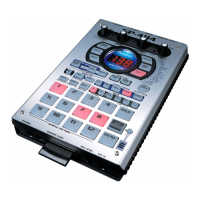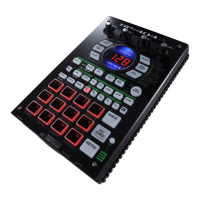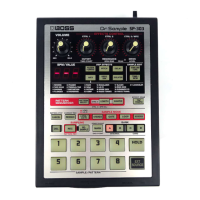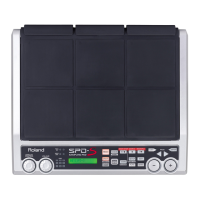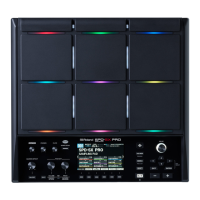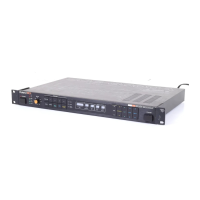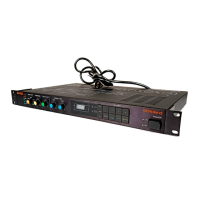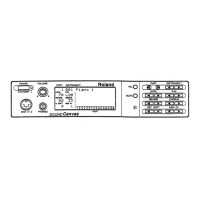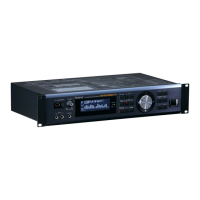Do you have a question about the Roland SP-555 and is the answer not in the manual?
Highlights easy sampling to pads and loop capture for creative sound-on-sound sampling.
Provides crucial guidelines for safe operation, including electrical safety and environmental considerations.
Stresses the importance of backing up data before repairs due to potential loss.
Details the top and rear panel controls, jacks, and indicators of the SP-555.
Guides on how to apply effects to individual samples or the mic/line input.
Lists approximate sampling durations for internal memory and CompactFlash cards in STANDARD and LO-FI modes.
Details the procedure for erasing all samples from internal memory or CompactFlash.
Guides on capturing audio phrases from external sources like CD players via LINE IN.
Guides on saving captured phrases as samples to specific pads.
Explains how to adjust the playback volume for each individual sample.
Guides on setting the start and end points to define the sample's playback range.
Details procedures for precisely adjusting both the start and end points of a sample.
Explains how to correct the BPM (tempo) of a sample if it's calculated incorrectly.
Explains how patterns are organized in banks and how to set the pattern tempo.
Provides a step-by-step guide for recording performances as patterns, including tempo and quantization.
Details how to erase incorrect notes or performances from a recorded pattern.
Explains procedures for deleting specific patterns or all patterns from memory.
Explains how to use the D Beam controller to play the built-in monophonic synthesizer and control pitch.
Describes how to use the D Beam controller to adjust the filter cutoff frequency.
Explains how to use the D Beam controller to trigger specific pads.
Guides on installing the software for converting audio files between SP-555 and computer formats.
Covers procedures for backing up and restoring the SP-555's settings and data to/from CompactFlash.
Guides on resetting all SP-555 settings, samples, and patterns to their factory defaults.
Explains how to erase internal memory data and reset settings to default states.
Provides a table summarizing common sampling tasks and their procedures.
Summarizes common tasks related to loop capture recording and playback.
Summarizes operations for controlling D Beam settings for synth, filter, and trigger modes.
Summarizes tasks related to formatting, importing, exporting, and managing backup data on CompactFlash.
Summarizes procedures for applying, assigning, and managing effects.
Summarizes procedures for playing, recording, and managing patterns.
Summarizes procedures for adjusting system-level settings like MIDI, illumination, and protection.
Summarizes procedures for configuring USB audio input/output settings.
Summarizes V-LINK operations like turning on/off and switching modes.
Offers solutions for problems related to no sound or low volume from various connections.
Covers issues like insufficient memory, incorrect card usage, and excessive noise during sampling.
Explains potential data loss in internal memory due to power interruption during writing.
Guides on setting up MIDI sync modes for tempo and playback synchronization.
Details how to sync pattern playback and tempo with an external MIDI sequencer.
Covers core sampling features like polyphony, frequency, data format, and sampling modes.
Highlights easy sampling to pads and loop capture for creative sound-on-sound sampling.
Provides crucial guidelines for safe operation, including electrical safety and environmental considerations.
Stresses the importance of backing up data before repairs due to potential loss.
Details the top and rear panel controls, jacks, and indicators of the SP-555.
Guides on how to apply effects to individual samples or the mic/line input.
Lists approximate sampling durations for internal memory and CompactFlash cards in STANDARD and LO-FI modes.
Details the procedure for erasing all samples from internal memory or CompactFlash.
Guides on capturing audio phrases from external sources like CD players via LINE IN.
Guides on saving captured phrases as samples to specific pads.
Explains how to adjust the playback volume for each individual sample.
Guides on setting the start and end points to define the sample's playback range.
Details procedures for precisely adjusting both the start and end points of a sample.
Explains how to correct the BPM (tempo) of a sample if it's calculated incorrectly.
Explains how patterns are organized in banks and how to set the pattern tempo.
Provides a step-by-step guide for recording performances as patterns, including tempo and quantization.
Details how to erase incorrect notes or performances from a recorded pattern.
Explains procedures for deleting specific patterns or all patterns from memory.
Explains how to use the D Beam controller to play the built-in monophonic synthesizer and control pitch.
Describes how to use the D Beam controller to adjust the filter cutoff frequency.
Explains how to use the D Beam controller to trigger specific pads.
Guides on installing the software for converting audio files between SP-555 and computer formats.
Covers procedures for backing up and restoring the SP-555's settings and data to/from CompactFlash.
Guides on resetting all SP-555 settings, samples, and patterns to their factory defaults.
Explains how to erase internal memory data and reset settings to default states.
Provides a table summarizing common sampling tasks and their procedures.
Summarizes common tasks related to loop capture recording and playback.
Summarizes operations for controlling D Beam settings for synth, filter, and trigger modes.
Summarizes tasks related to formatting, importing, exporting, and managing backup data on CompactFlash.
Summarizes procedures for applying, assigning, and managing effects.
Summarizes procedures for playing, recording, and managing patterns.
Summarizes procedures for adjusting system-level settings like MIDI, illumination, and protection.
Summarizes procedures for configuring USB audio input/output settings.
Summarizes V-LINK operations like turning on/off and switching modes.
Offers solutions for problems related to no sound or low volume from various connections.
Covers issues like insufficient memory, incorrect card usage, and excessive noise during sampling.
Explains potential data loss in internal memory due to power interruption during writing.
Guides on setting up MIDI sync modes for tempo and playback synchronization.
Details how to sync pattern playback and tempo with an external MIDI sequencer.
Covers core sampling features like polyphony, frequency, data format, and sampling modes.
| Type | Sampler |
|---|---|
| Number of Pads | 16 |
| Sub Pad | Yes |
| Sampling Frequency | 44.1 kHz |
| Maximum Polyphony | 12 voices |
| Bit Depth | 16-bit |
| Data Format | WAV, AIFF |
| MIDI In/Out | Yes |
| Display | Backlit LCD |
| USB | Yes (for data transfer) |
| Storage | Compact Flash |
| Connectors | USB, MIDI |
| Power Supply | AC adapter |
| Signal Processing | 24-bit (A/D, D/A) |
| Sample Memory | 64MB (approx. 12 minutes mono/6 minutes stereo) |
| Audio Inputs | 2 x 1/4" TRS |
| Audio Outputs | 2 x 1/4" TRS |
